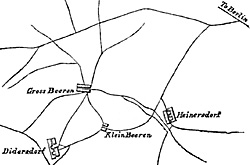
At the battle of Gross Beeren, a few months later in the same year, the part played by the artillery on both sides was very considerable, and indeed this may almost be termed a purely artillery combat, because the pouring rain in which it was fought confined the infantry to the use of the bayonet alone. The battle was also remarkable from an artillery point of view, because it furnishes us with an example of artillery masses brought early into action after the manner which the Germans have made the fashion in the present day, and of a close co-operation of guns with the final assault, such as their mobility had hitherto scarcely rendered possible.
Napoleon, whose eyes were ever fixed on Berlin while he fought the Allied armies round Dresden, had despatched three corps under Oudinot to operate against Bernadotte, who was in command of the Allied force which was covering the Prussian capital.
On the 23rd of August, Oudinot directed Regnier to attack Gross Beeren with the 7th Corps, and the French coming on in superior numbers easily gained possession of the village, and established themselves close to the very Centre of the Allied line. The same day Oudinot was himself engaged with the enemy on the left, while Bertrand was also fighting on the right. The three corps were separated by difficult country, and united action between them was impossible. The Allied reserve under Bulow had moved to its left to support Tauentzein against Bertrand, but, the situation at the allied Centre becoming critical, he was recalled to oppose Reynier's dangerous inroad, and advanced to the support of the Centre which was clinging to some woods behind the village, with his whole corps from Heinersdorf.
The ground being favourable for the employment of artillery, and the heavy rain having rendered muskets useless, the Allies covered their advance with a great mass of guns, which preceded the infantry and commenced the engagement in an unusually bold manner. Thirty-six Prussian pieces and a Russian 12-pr. battery under Lieut Colonel von Holzendorf opened fire at 1800 paces, and kept up a lively cannonade, while the guns pressed forward by alternate batteries. The infantry followed at a distance of 300 paces. The French guns were numerous and caused much destruction to the allied artillery. It, therefore, speedily became necessary to reinforce it, and sixty-four pieces were accordingly brought up within 700 or 800 yards of the French position, and soon this number was further increased to eighty-two, while a Swedish battery was sent to the right to take the French in flank.
Regnier's artillery ere long began to show the effect of this concentrated fire, and by degrees became almost completely silent. Then Billow led his infantry to the attack, and their enemy's position was carried at the point of the bayonet.
When this advance was made Colonel Holzendorf mounted his gunners on the carriages of the 6-pdrs, in a manner then quite original, and they were thus enabled to press forward rapidly and co-operate with the infantry at the shortest ranges. The village was soon gained by this well prepared assault, and the defeat of the French, who were cut off by the nature of the country from any help from their comrades on either side, was completed by the cavalry of the allies.
Holzendorf's promptness in mounting his gunners and pressing on with the infantry has been much praised, and, indeed, the manner in which the artillery was handled throughout the day appears especially deserving of notice. While the early massing of guns must chiefly attract attention, it should also be noted that the foot and horse artillery were likewise separated in an unusual way, and, while the former acted against the front, the latter engaged the flank of the enemy's position.
General Bulow [4] in his account of this battle has warmly eulogised the courage shown by officers and men, and has particularly praised the activity of the artillery, which contributed so largely to the victory, not only by its concentrated fire at the commencement of the fight but by the general manner in which it subsequently supported the advance.
More Achievements of Field Artillery Part II
Achievements of Field Artillery The Era of Napoleon: Part I
Back to Age of Napoleon 30 Table of Contents
Back to Age of Napoleon List of Issues
Back to MagWeb Master List of Magazines
© Copyright 1999 by Partizan Press.
This article appears in MagWeb (Magazine Web) on the Internet World Wide Web.
Other military history articles and gaming articles are available at http://www.magweb.com